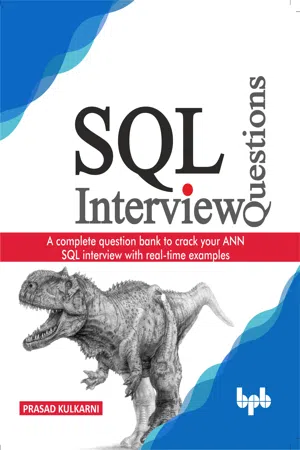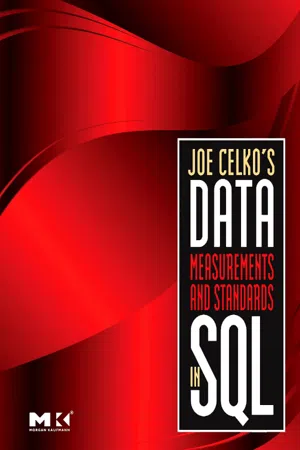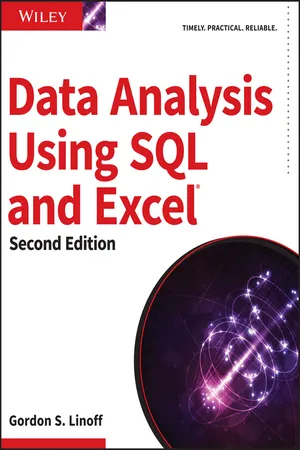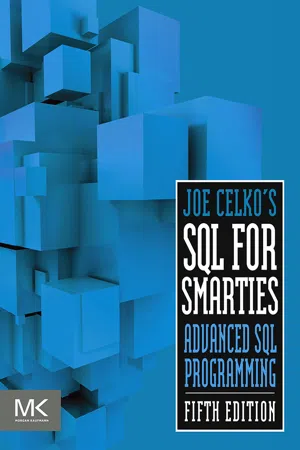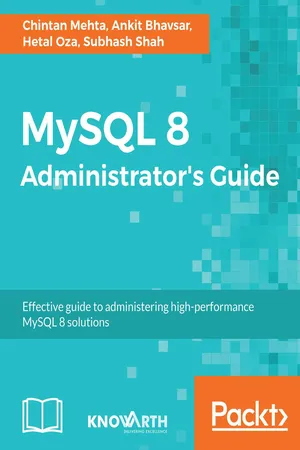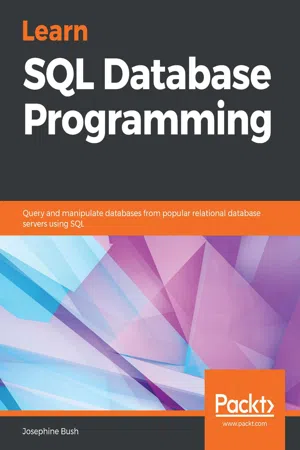Computer Science
SQL Datetime Value
A SQL Datetime Value is a data type used in SQL databases to store date and time information. It includes both the date and time components, and can be used for a variety of purposes such as tracking events or scheduling tasks. The format for a SQL Datetime Value is typically YYYY-MM-DD HH:MM:SS.
Written by Perlego with AI-assistance
Related key terms
10 Key excerpts on "SQL Datetime Value"
- eBook - ePub
Joe Celko's SQL for Smarties
Advanced SQL Programming
- Joe Celko(Author)
- 2010(Publication Date)
- Morgan Kaufmann(Publisher)
SQL only supports what are called nonsequenced operations. Standard SQL has a very complete description of its temporal data types. There are rules for converting from numeric and character strings into these data types and there is a schema table for global time-zone information that is used to make sure that temporal data types are synchronized. It is so complete and elaborate that smaller SQLs have not implemented it yet. As an international standard, Standard SQL has to handle time for the whole world, and most of us work with only local time. If you have ever tried to figure out the time in a foreign city to place a telephone call, you have some idea of what is involved.The common terms and conventions related to time are also confusing. We talk about “an hour” and use the term to mean a particular point within the cycle of a day (“The train arrives at 13:00 hrs”) or to mean an interval of time not connected to another unit of measurement (“The train takes three hours to get there”). The number of days in a month is not uniform; the number of days in a year is not uniform; weeks are not easily related to months; and so on.Standard SQL has two basic kinds of temporal data types. The datetimes (DATE , TIME , and TIMESTAMP ) represent points in the time line, and the interval data types and INTERVAL s (DAY , HOUR , MINUTE , and SECOND with decimal fraction) are durations of time. Standard SQL also has a full set of operators for these data types. But you will still find vendor-specific syntax in most existing SQL implementations today.11.2.1 Internal Representations
The syntax and power of date, timestamp, and time features vary so much from product to product that it is impossible to give anything but general advice. This chapter will assume that you have simple date arithmetic in your SQL, but you might find that some library functions would let you do a better job than what you see here. Please continue to check your manuals until the Standard SQL standards are implemented. - eBook - ePub
Joe Celko's SQL for Smarties
Advanced SQL Programming
- Joe Celko(Author)
- 2010(Publication Date)
- Morgan Kaufmann(Publisher)
Standard SQL has a very complete description of its temporal data types. There are rules for converting from numeric and character strings into these data types, and there is a schema table for global time-zone information that is used to make sure temporal data types are synchronized. It is so complete and elaborate that nobody has implemented it yet—and it will take them years to do so! Because it is an international standard, Standard SQL has to handle time for the whole world, and most of us work with only local time. If you have ever tried to figure out the time in a foreign city before placing a telephone call, you have some idea of what is involved.The common terms and conventions related to time are also confusing. We talk about “an hour” and use the term to mean a particular point within the cycle of a day (“The train arrives at 13:00”) or to mean an interval of time not connected to another unit of measurement (“The train takes three hours to get there”); the number of days in a month is not uniform; the number of days in a year is not uniform; weeks are not related to months; and so on.All SQL implementations have a DATE data type; most have a separate TIME and a TIMESTAMP data type. These values are drawn from the system clock and are therefore local to the host machine. They are based on what is now called the Common Era calendar, which many people would still call the Gregorian or Christian calendar.Standard SQL has a set of date and time (DATE, TIME, and TIMESTAMP) and INTERVAL (DAY, HOUR, MINUTE, and SECOND, with decimal fraction) data types. Both of these groups are temporal data types, but datetimes represent points in the time line, while the interval data types are durations of time. Standard SQL also has a full set of operators for these data types. The full syntax and functionality have not yet been implemented in any SQL product, but you can use some of the vendor extensions to get around a lot of problems in most existing SQL implementations today. - eBook - ePub
SQL Interview Questions
A complete question bank to crack your ANN SQL interview with real-time examples
- Prasad Kulkarni(Author)
- 2019(Publication Date)
- BPB Publications(Publisher)
hh:mm:ss:nnnn . The date ranges between 0001-01-01 and 9999-12-31, and the time ranges between 00-00-00 and 23-59-59.- YYYY is the year and it ranges from 0001 to 9999.
- MM is the month and it ranges from 1 to 12 (from January to December).
- DD is the day and it ranges from 1 to 31.
- hh is the hour unit and it ranges between 00 and 23.
- mm is the minute unit and it ranges between 00 and 59.
- ss is the seconds and it ranges between 00 and 59.
- nn is the nano-seconds and it ranges between 00 and 999.
Basically, time is stored as string, where the max value is 19-23 characters (YYYY-MM-DD hh:mm: ss) The storage capacity for time datatype is fixed, which is 8 bytes, and if you leave this field empty, then the default value is 1900-01-01 00:00:00.When you want to store both date and time value in a single column, then you can use this datatype.Real-time example: If you want to store student's birthday with date and time, then you can define a column with datetime datatype.If you want more options in seconds precision the you can use datetimeoffset datatype and to support different time zones, you can use datetimeoffset .Miscellaneous SQL datatypes
The previous sections of datatypes covered most of the type of datatypes used to store in SQL, but apart from that we also have a few more datatypes that can be used to store different values. Go through the following datatypes for more details:- xml: This datatype was introduced in version SQL 2008, and as the name suggests, this datatype is used to store xml instance in column. The data size of the XML should not be more than 2 GB. Here XML datatype has some rule while storing data:
- There should be one or more nodes
- There must be only one root element
- You can create optional schema if needed
- You can store contents or document as XML
- eBook - ePub
Developing Robust Date and Time Oriented Applications in Oracle Cloud
A comprehensive guide to efficient date and time management in Oracle Cloud
- Michal Kvet(Author)
- 2023(Publication Date)
- Packt Publishing(Publisher)
of implementation.Although currently, some standards exist for particular goals, generally, database systems just use them as a reference (as ideas) but create their own solutions to meet their requirements. Consequently, each system has its own dialect, usability properties, and specific implementation requirements.Soon after the release of the first database system, sophisticated techniques were required by users and developers. Thus, individual vendors had to specify functionality and management principles. Moreover, the whole process was not synchronized, resulting in various system representations.In this chapter, we will cover the following main topics:- Date and time references in relational databases
- Date and time standardization principles, focusing on ISO 8601
- Modeling date and time elements and composite values
- Modeling a period of time
Understanding relational database integrity
Relational databases were introduced in the 1960s, formed by the entities and relationships between them and influenced by relational algebra. The transaction support covered security, consistency, and integrity, ensuring atomicity, consistency, isolation, and durability.In the field of databases, the concept of integrity is understood in terms of accuracy and correctness by ensuring data consistency. Moreover, it is often associated with data confidentiality. The integrity problem is, therefore, associated with ensuring any changes made to the database are correct. Errors and consequent data inconsistencies can be caused by data entry, operator errors, program errors, or even intentional database corruption attempts. - Joe Celko(Author)
- 2009(Publication Date)
- Morgan Kaufmann(Publisher)
There should also be a function that returns the current date from the system clock. This function has a different name with each vendor: TODAY, SYSDATE, and getdate() are dialect for the correct CURRENT_DATE or CURRENT_TIME_STAMP. There may also be a function to return the day of the week from a date, which is sometimes called DOW() or WEEKDAY(). Standard SQL provides for CURRENT_DATE, CURRENT_TIME [(<time precision>)] and CURRENT_TIMESTAMP [(<timestamp precision>)] functions, which are self-explanatory.41.4. The Nature of Temporal Data Models
Temporal data is pervasive. It has been estimated that 1 of every 50 lines of database application code involves a date or time value. Data warehouses are by definition time-varying: Ralph Kimball states that every data warehouse has a time dimension. Often the time-oriented nature of the data is what lends it value.Integers, decimal numbers, strings, Boolean values, and most other data that we put into a computer are discrete. Time and real numbers are is a continuum. In a continuum, a value is not always known exactly. Consider the number pi (π); you can approximate it with a real number (3.141592653…) or a rational number (22/7), but you cannot express it exactly.When we give a date, say “2009-12-31,” it is really a duration that starts at exactly “2009-12-31 00:00:00” but it ends just before “2010-01-01 00:00:00.” This is called a half-open interval in mathematics.We are stuck with expressing the end of that day to whatever precision we have in my machine—say “2009-12-31 23:59:59.999999999” if we have nanoseconds in the hardware. Technically, we cannot use “2009-12-31 24:00:00” since that time does not exist in the ISO standards and in many SQL products it would “round” to “2010-01-01 00:00:00” anyway.MySQL uses a proprietary notation for periods of years and year-months, so they can be expressed in a single column. They fill in the day or year field with “00” so that “2009-01-00” is the entire month of January 2009 and likewise “2009-00-00” is the entire year of 2009. Most other SQL products have to use {start_time, end_time} pairs that declare the end_time to be NULL-able so that an ongoing state of affairs can be modeled. You use the expression COALESCE (end_time, CURRENT_TIMESTAMP) in VIEWS or queries for the current situation, or COALESCE (end_time, ≪dead line timestamp≫) when there is a required ending time.- eBook - ePub
- Gordon S. Linoff(Author)
- 2015(Publication Date)
- Wiley(Publisher)
Even rational businesses invent their own calendars. Many companies observe fiscal years that start on days other than the first of January, and some use a 5-4-4 system as their fiscal calendar. The 5-4-4 system describes the number of weeks in a month, regardless of whether the days actually fall in the calendar month. All of these are examples of calendar systems, whose particular characteristics strive to meet different needs.Given the proliferation of calendars, it shouldn’t be surprising that databases handle and manage dates and times in different ways. Each database stores dates in its own internal format. What is the earliest date supported by the database? How much storage space does a date column require? How accurate is a time stamp? The answers are specific to the database implementation and to the types supported by the database. However, databases do all work within the same framework, the familiar Gregorian calendar, with its yearly cycle of 12 months and a leap year almost every four years. The next few sections discuss some of the particulars of using these data types.Some Fundamentals of Dates and Times in Databases
Dates and times have their own data types. The ANSI standard types are DATETIME and INTERVAL , depending on whether the value is absolute or a duration. Each of these can also have a specified precision, typically in days, seconds, or fractions of a second. The ANSI standard provides a good context for understanding the data types, but every database handles them differently. The aside “Storing Dates and Times in Databases” discusses different ways that date and time values are physically stored.This section discusses topics such as extracting components, measuring intervals, and handling time zones. In addition, it introduces the Calendar table, which describes features of days and is included on the companion website.Extracting Components of Dates and Times
The six important components of date and time values are year, month, day of month, hour, minute, and second. For understanding customers, year and month are typically the most important components. The month captures seasonality in customer behavior, and the year makes it possible to look at changes over longer periods of time. - eBook - ePub
Joe Celko's SQL for Smarties
Advanced SQL Programming
- Joe Celko(Author)
- 2014(Publication Date)
- Morgan Kaufmann(Publisher)
Standard SQL has a very complete description of its temporal data types. There are rules for converting from numeric and character strings into these data types, and there is a schema table for global time-zone information that is used to make sure that temporal data types are synchronized. It is so complete and elaborate that smaller SQLs have not implemented it yet. As an international standard, SQL has to handle time for the whole world and most of us work with only local time. If you have ever tried to figure out the time in a foreign city to place a telephone call, you have some idea of what is involved.The common terms and conventions related to time are also confusing. We talk about “an hour” and use the term to mean a particular point within the cycle of a day (The train arrives at 13:00 Hrs) or to mean an interval of time not connected to another unit of measurement (The train takes three hours to get there), the number of days in a month is not uniform, the number of days in a year is not uniform, weeks are not easily related to months, and so on.Standard SQL has a set of date, time (DATE, TIME, and TIMESTAMP), and INTERVALs (DAY, HOUR, MINUTE, and SECOND with decimal fraction) data types. They are made up of fields which are ordered within the value; they are YEAR, MONTH, DAY, HOUR, MINUTE, and SECOND. This is the only place in SQL that we use the term “field”; new SQL programmers too often confuse the term field as used in file systems with the column concept in RDBMS. They are very different.Both of these are temporal data types, but datetimes represent points in the time line, while the interval data types are durations of time, not anchored at a point on the timeline. Standard SQL also has a full set of operators for these data types. But you will still find vendor syntax in most SQL implementations today.12.3.1 Tips for Handling Dates, Timestamps, and Times
The syntax and power of date, timestamp, and time features vary so much from product to product that it is impossible to give anything but general advice. This chapter will assume that you have simple date arithmetic in your SQL, but you might find that some library functions would let you do a better job than what you see here. Please continue to check your manuals until the Standard SQL operators are implemented. - Joe Celko(Author)
- 2008(Publication Date)
- Morgan Kaufmann(Publisher)
Temporal TablesS QL IS THE first programming language to have temporal data types in it. If COBOL had done this, we would never have had the “Y2K Crisis” in IT. However, each SQL product has its own version of temporal data types and functions, in spite of ANSI/ISO Standards. In 2007, the United States decided to change when Daylight Saving Time (DST) would start. The result was a “mini-crisis” because the Windows operating system had the old rule built into it and not everyone made the switchover. In Standard SQL, the entire schema is supposed to be on Universal Coordinated Time (UTC) and then converted to local lawful time—that means time zones and DST conversions for display purposes.9.1 The Nature of Time
Time is not a simple thing. Most data processing is done with data that is discrete by its nature. An account number is or is not equal to a value. A measurement has a value to so many decimal places. But time is a continuum, which means that given any two values on the time line, you can find an infinite number of points between them. Then we have the problem of which kind of infinite. Most nonmath majors do not even know that some transfinite numbers are bigger than others!Do not panic. For purposes of a database the rule we need to remember is that “Nothing happens instantaneously” in the real world. Einstein declared that duration in time is the fourth dimension that everything must have to exist. But before Einstein, the Greek philosopher Zeno of Elea (circa 490 to 430 BCE) wrote several paradoxes, but the one that will illustrate the point about a continuum versus a discrete set of points is the Arrow Paradox.Aristotle stated the Arrow Paradox this way in his Physics VI:9: “If everything when it occupies an equal space is at rest, and if that which is in locomotion is always occupying such a space at any moment, the flying arrow is therefore motionless.”More informally, imagine you shoot an arrow into the air. It moves continuously from your bow to the target in some finite amount of time. Look at any instant in that period of time. The arrow cannot be moving during that instant because an instant has no duration amd your arrow cannot be in two different places at the same time. Therefore, at every instant in time the arrow is motionless. If this is true for all instants of time, then the arrow is motionless during the entire interval. The fallacy is that there is no such thing as an instant in time. But the Greeks only had geometry, and the ideas of the continuum had to wait for calculus. If you want more details on the topic, get a copy of A Tour of the Calculus- eBook - ePub
- Chintan Mehta, Ankit K Bhavsar, Hetal Oza, Subhash Shah(Authors)
- 2018(Publication Date)
- Packt Publishing(Publisher)
The DATE data type is suitable when the values we wish to store have a date part, but the time part is missing. The standard MySQL date format is YYYY-MM-DD. The date values are retrieved and displayed in the standard format unless DATE functions are applied. The MySQL supported range of values is 1000-01-01 to 9999-12-31. Supported, here, means the values may work, but there is no guarantee. The same is the case for the DATETIME data type.The DATETIME data type is suitable for values containing date and time parts. The standard MySQL DATETIME format is YYYY-MM-DD HH:MM:SS. The supported range of values is 1000-01-01 00:00:00 to 9999-12-31 23:59:59.Similar to DATETIME, the TIMESTAMP data type is also suitable for values containing date and time parts. However, the range of values supported by the TIMESTAMP data type is 1970-01-01 00:00:01 UTC to 2038-01-19 03:14:07 UTC.Though they look similar, the DATETIME and TIMESTAMP data types differ significantly:- The TIMESTAMP data type requires 4 bytes to store date and time values. The DATETIME data type requires 5 bytes to store date and time values.
- TIMESTAMP can store values till 2038-01-19 03:14:07 UTC. If we wish to store values beyond 2038, the DATETIME data type should be used.
- TIMESTAMP considers UTC as the time zone while storing values. DATETIME stores values without time zone consideration.
Let's create a table called datetime_temp. The table has two columns; one is DATETIME and another is of the type TIMESTAMP. We will store the same date and time values in both columns. With the help of the SELECT query, we will try to understand how the representations differ - eBook - ePub
Learn SQL Database Programming
Query and manipulate databases from popular relational database servers using SQL
- Josephine Bush(Author)
- 2020(Publication Date)
- Packt Publishing(Publisher)
This data type can hold a date in the format of YYYY-MM-DD. The range is from '1000-01-01' to '9999-12-31'. For example, December 15, 1997, would be stored as 1997-12-15.- TIME: This data type holds time values in the format of hh:mm:ss. The range is from '-838:59:59' to '838:59:59'.
- DATETIME:
This data type can hold a combination of date and time in the format of YYYY-MM-DD hh:mm:ss. The range is from '1000-01-01 00:00:00' to '9999-12-31 23:59:59'. For example, January 19, 2003, at 3:30 p.m. would be stored as 2003-01-19 15:30:00.- TIMESTAMP: This data type can hold values that contain both date and time parts. This has a range of '1970-01-01 00:00:00' UTC to '2038-01-19 03:14:07' UTC (Coordinated Universal Time; formerly Greenwich Mean Time) . The value is stored in the number of seconds since '1970-01-01 00:00:00'.
The significant difference between DATETIME and TIMESTAMP is that TIMESTAMP values are stored in UTC and converted to the current timezone when a query returns the values. In contrast, DATETIME data type values are stored in the current time zone.- YEAR: This data type can hold the values of a year in four-digit format. The range is 1901 to 2155, and 0000.
Passage contains an image
MySQL date and time data type table summary
The following table lists the date and time data types available in MySQL:Data Type Description Storage Used DATE Stores dates in the format 'YYYY-MM-DD' Ranges from '1000-01-01' to '9999-12-31' 3 bytes TIME Stores time in format: hh:mm:ss Ranges from '-838:59:59' to '838:59:59' 3 bytes DATETIME Stores date and time combination in format YYYY-MM-DD hh:mm:ss Ranges from '1000-01-01 00:00:00' to '9999-12-31 23:59:59' 8 bytes TIMESTAMP Stores time in number of seconds since '1970-01-01 00:00:00' UTC Ranges from '1970-01-01 00:00:01' UTC to '2038-01-09 03:14:07' UTC 4 bytes YEAR Stores year in four-digit format Ranges from 1901 to 2155, and includes 0000 1 byte The preceding table lists the date and time data types available in MySQL. It's important to note the storage used because the less storage you use, the better it is for performance. The Choosing the right data type section covers the reasons behind this.
Index pages curate the most relevant extracts from our library of academic textbooks. They’ve been created using an in-house natural language model (NLM), each adding context and meaning to key research topics.


